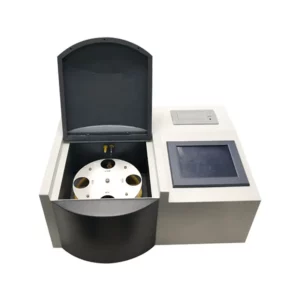An Oleic Acid Tester is an analytical instrument designed to measure the concentration or content of oleic acid in various materials. Oleic acid is a monounsaturated fatty acid that is commonly found in various natural sources, including vegetable oils, animal fats, and some industrial processes.
Here’s an explanation of what an Oleic Acid Tester is and how it is used in laboratory or industrial applications:
Oleic Acid Tester:
- An Oleic Acid Tester is an analytical device specifically designed for the quantification of oleic acid content in a sample. It typically employs chemical analysis techniques to determine the concentration of oleic acid, which is a key component in various substances, especially in edible oils and industrial applications.
Usage in Laboratory Applications:
- In laboratory settings, Oleic Acid Testers are used for research, quality control, and analytical purposes. They enable scientists and analysts to precisely measure the oleic acid content in different samples, including oils, fats, and other materials.
- Researchers and quality control personnel use Oleic Acid Testers to assess the purity and quality of oils used in the food industry, cosmetic products, and pharmaceutical formulations.
- These testers are also used in academic and industrial research to study the composition and characteristics of oleic acid in various substances, helping to understand its properties and applications.
Usage in Industrial Applications:
- In industrial applications, Oleic Acid Testers are employed for quality control and process optimization. They play a crucial role in industries that utilize oleic acid as a raw material, such as soap manufacturing, chemical production, and biodiesel production.
- Manufacturers of products like soaps, detergents, and cosmetics use Oleic Acid Testers to ensure the desired oleic acid content in their formulations.
- In the biodiesel industry, Oleic Acid Testers are used to monitor and control the oleic acid content in feedstocks, as it can influence the quality and properties of biodiesel fuels.
Working Principle:
- Oleic Acid Testers typically utilize chemical methods to quantify oleic acid. Common techniques include titration, gas chromatography, and high-performance liquid chromatography (HPLC). These methods involve the reaction of oleic acid with specific reagents or the separation of oleic acid from other components for precise measurement.
Significance:
- Oleic acid content is significant because it affects the properties and quality of various products. In the food industry, it can impact the taste, texture, and shelf life of oils and food products. In industrial processes, it can influence the characteristics of chemical products.
In summary, an Oleic Acid Tester is an analytical instrument used to determine the oleic acid content in various materials. It is valuable in both laboratory and industrial settings for quality control, research, and process optimization, Oleic Acid Tester ensuring that oleic acid meets specific requirements and standards in different applications.
What are the standard test methods and procedures employed by an Oleic Acid Tester to measure oleic acid content?
The standard test methods and procedures employed by an Oleic Acid Tester to measure oleic acid content depend on the specific technology and instrument used. Several techniques are commonly employed for oleic acid analysis, and each has its own set of procedures.
Here are two common methods:
- Titration Method:
- The titration method is widely used to determine oleic acid content in various samples, including oils and fats. It involves the reaction of oleic acid with a reagent of known concentration (typically potassium hydroxide, KOH) to neutralize the acid.
- The following steps are involved in a typical titration procedure: a. Weigh a known quantity of the sample containing oleic acid. b. Dissolve the sample in a suitable solvent, such as ethanol or isopropanol. c. Add a few drops of a pH indicator, such as phenolphthalein, to the sample. d. Titrate the solution with a standardized KOH solution until the pH reaches a certain endpoint, typically pH 8.2. e. Record the volume of KOH required to neutralize the acid.
- The oleic acid content is then calculated based on the volume and concentration of the KOH solution used in the titration.
- Gas Chromatography (GC):
- Gas chromatography is a highly accurate technique for oleic acid analysis. It involves the separation of individual fatty acids, including oleic acid, from a sample based on their chemical properties.
- The procedure for oleic acid analysis by GC includes the following steps: a. Prepare a sample by extracting and derivatizing the fatty acids. b. Inject the derivatized sample into the GC system. c. Separate the individual fatty acids based on their retention times. d. Quantify oleic acid by comparing its peak area or height with standards of known concentrations.
- GC is known for its high precision and the ability to differentiate between various fatty acids present in a sample.
The choice of method and specific procedures can vary based on the instrument, laboratory practices, and the type of sample being analyzed. In some cases, laboratories may adopt established industry or organization-specific standards for oleic acid analysis.
It’s important to note that, in addition to these methods, there are other advanced analytical techniques, such as high-performance liquid chromatography (HPLC), which can also be used for oleic acid analysis. The selection of the method depends on factors like precision requirements, the type of sample, and the available equipment and expertise in the laboratory.
Users of Oleic Acid Testers should follow the manufacturer’s guidelines, as well as relevant industry standards, to ensure accurate and reliable oleic acid content measurements.
